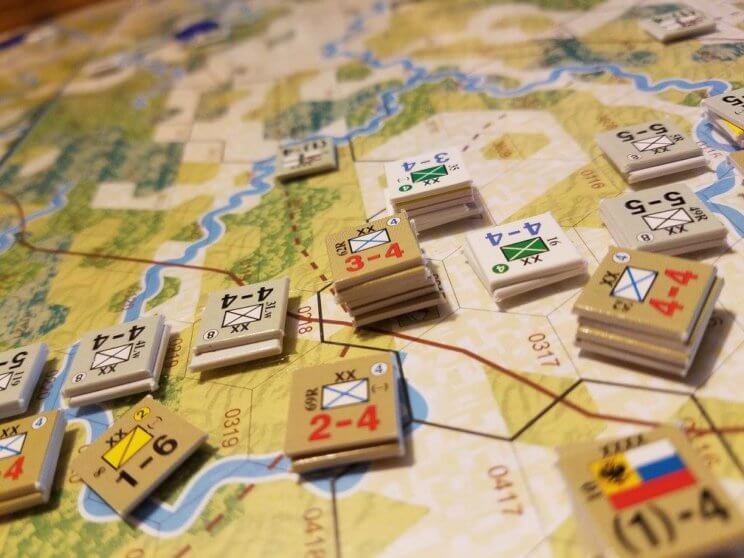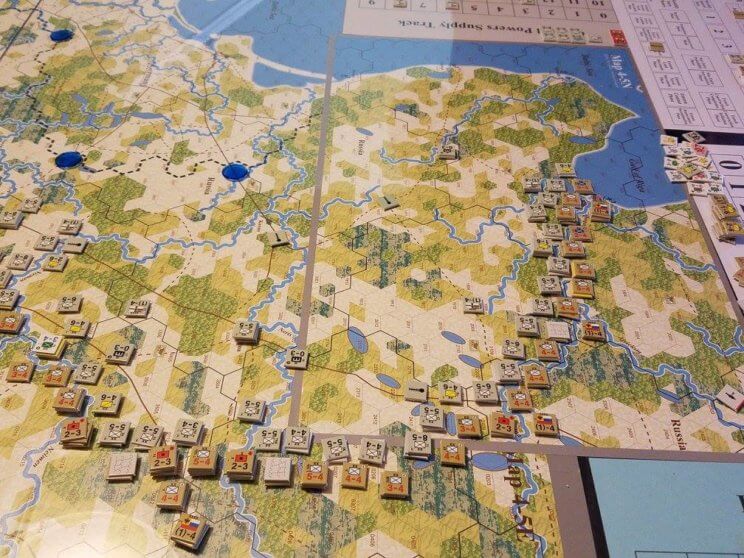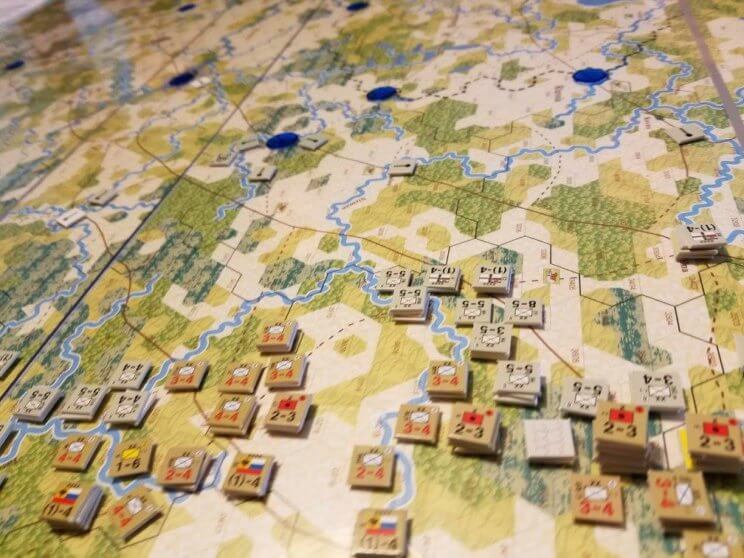As mentioned a few weeks ago, one of my favorite game series is the Der Weltkrieg Simulation Series by Schroeder Publishing & Wargames. The Der Weltkrieg Simulation Series (hereafter referred to as DWK) consists of four individual games covering operational level campaigns on the different fronts of World War One. These individual games contain rules that allow them to be combined with each other in various ways so that they can be played together. For those who want the ultimate WWI experience SPW offers The Grand Campaign, which not only ties the entire series together, but offers rules for the strategic, economic, and productions aspects of the war.

What follows is a quick overview of the standard DWK system. I won’t be covering any of the special aspects found in either The Grand Campaign or any of the game specific rules. As stated in a previous post I think the DWK rules are some of the finest wargame rules out there. They’re very concise and to the point and despite the large number of sections listed in the table of contents they’re very reasonable in size. The Sterling Edition of the Standard Rules can be found in the rules section of the SPW website.
SEQUENCE OF PLAY
Each month of game time in DWK is broken into eight turns, one Monthly Special Turn followed by seven Normal Turns. The Monthly Special Turn consists of trench construction allowing you to start new trenches or complete ones already under construction. There are strict rules covering when and where trench construction can take place in order to keep players from building them wherever they feel like.
Each Normal Turn consists of two player turns of four phases each: Reinforcement Arrival Phase, Movement Phase, Combat Phase, and the Replacement/Recombination Phase. The Central Powers always take their turn first followed by the Entente. Once the seventh turn of the month is complete, advance the month and turns makers, rinse and repeat.
REINFORCEMENT ARRIVAL PHASE
Each scenario has a reinforcement schedule that is used during play. During the Reinforcement Arrival Phase the active player checks that reinforcement schedule and places their arriving combat units, HQs, replacement units, and/or supply points at the given locations. Units that arrive during the Reinforcement Arrival Phase are considered to have completed Mobilization (which I’ll touch on in the Movement Phase) and can be moved normally during the upcoming turn.
MOVEMENT PHASE
One of the unique features of DWK is the way that terrain is handled on the map. All of the terrain is hex-side based, meaning that instead of moving or fighting into a “Woods” hex your units move or fight across a “Woods” hex-side. It’s a neat little twist on things that I wasn’t too sure about when I first got into the system but one of those aspects that I really like about it now.
Other than dealing with the hex-side based terrain most of the movement rules are pretty standard. Units are given a movement allowance, crossing certain terrain types will cost you more than other types, enemy zones of control effect cost, and of course units can’t save or share movement allowances with other units. (My one goal in life is to design a game where a unit can store up its movement allowance for like ten turns and then travel at ten times its normal movement allowance or give some of that allowance to a unit it’s stacked with – but I digress).
Some units can use Column Movement to increase their base Movement Allowance. This will allow a unit to move up to 50% further than it would be able to otherwise as long as it does not enter an EZOC. Another option that some units have is to perform a Column Attack during their movement, which is basically a reduced strength overrun combat which is great for clearing out screening calvary or weaker combat units. Once a Column Attack is resolved the moving units are not allowed to move any further.
Scenarios that begin at the beginning of the war also have Mobilization Schedules. A unit that is on the map that hasn’t completed its mobilization can not move unless it’s attacked. This leads to some very quick turns at the beginning of some scenarios. In The Schlieffen Plan, for example, of all of the German units on the board at start, only three or four infantry divisions can actually move during the first turn. Other units, from both sides, are then slowly mobilized until all units are free to move. It can be kind of a pain in the ass to keep track of which units have been mobilized during play but as most units complete mobilization within the first four or five turns it’s not all that bad.
You’ll notice in the picture above that there are several rail-lines running through the terrain. Not only do these help reduce the cost of some normal movement across costly hex-sides but allow capable units and supply to be moved by rail. Rail movement works by first having the unit entrain, usually at a cost of 1MP, and then spending a fraction, usually a tenth, of a movement point for each hex it moves through. The unit can then detrain, losing any fractional MA it may have left, and continue to move normally. Units from certain countries can even use rail movement to move directly into an EZOC and fight during the upcoming Combat Phase.
COMBAT PHASE
One of the other aspects I really enjoy about this game is how combat resolution is handled. First off, it’s strength based, meaning that if I can bring 56 strength points to an attack, I roll on the 56 column of the CRT. There are no combat ratios and 56 strength points are guaranteed to do so much damage (in the case of a scenario that takes place from 1914-1916, anywhere from three to fourteen points) regardless of the defender’s strength.
Secondly combat resolution is simultaneous when it comes to resolving losses. For example, if I make an initial attack against a stack with ten strength points, that stack will get an opportunity to counter-attack using that strength before taking its losses. By “using that strength” I mean using the full ten points to help determine its actual counter-attack strength. A counter-attacking stack usually gets to counter-attack at triple its current strength unless it either decides or is forced to retreat from the initial attack. If a stack retreats it still gets to double its current strength on the counter-attack.
And finally the most interesting aspect of combat resolution in my opinion is the supply involved. In order for a unit to attack or counter-attack at full strength it must be supplied. In order to be supplied it must be within range of an HQ unit that has sufficient supply associated with it. For an attacking infantry unit one supply point will supply four points of strength. For a counter-attacking infantry unit one supply point will supply only two points of strength. Units that are out of range (to a certain extent) can be partially supplied or choose to fight un-supplied which halves its strength.
There are, of course, many details that I’m leaving out as far as how supply is handled, forced retreats, defending terrain, taking losses, and so forth. I’m saving all of that for a detailed combat example sometime in the future.
RECOMBINATION PHASE
During play your side will obviously take a lot of losses. To help alleviate some of these loses you’ll be able to rebuild units that have been destroyed and strengthen existing weakened units. Units can be rebuilt or strengthened using the strength points from Replacement Units or other combat units of the same type. Replacement Units are not Combat Units and exist for the sole purpose of providing strength points for recombination.
During the recombination phase units that are stacked with an HQ unit for an entire turn may undergo recombination with other units that share the same Full Strength Symbol on the counter. Basically all of the points of a certain type are added up and those points are then used to combine units in that hex or bring back units that have been eliminated during play.
CONCLUSION
Once again, this is meant to be just a brief overview of the Der Weltkrieg Simulation Series. I’ve left off quite a bit of detail that I would like to cover in the future if there’s enough interest in me doing so. For anyone interested in playing WWI games I can not recommend this series highly enough, it is, by far, the best WWI system I’ve ever played.




Which game would you recommend as a starting point for someone new to the system?
The Der Weltkrieg Simulation Series has just been reprinted and all of the older Eastern Front games are now part of “Eastern Front: 1914-1917”. This is the one I would start with using the Tannenberg scenario as an intro to the system. You can probably find the old Tannenberg/Galicia module fairly cheap as well if you didn’t want to invest too much to see what the system is like. There were a couple of rule tweaks when the games were reprinted (supply cost being one of them), but nothing that changes the way the game plays.
Does the game feel historically accurate to you in terms of OOB, game dynamics, and scenario results?
I think, more than most games that I’ve played, that this series deserves the “Simulation” that is in its title. Now, I’m a WWI newbie when it comes to OOB and even scenario results, but from what I’ve played and what I’ve read about the conflict I’ve been really happy with the results.
Excellent article.I’m not a WWI fan, but you are an influence!
Thanks! I had very little interest in WWI until I was introduced to this system. I quickly realized just how embarrassingly bad my knowledge of the entire conflict was and decided to do a little reading here and there. I’ve found that the political situation leading up to WWI and the military actions in the first few months are really fascinating. I’ve been slowly working my way through “The Sleepwalkers” which covers, in great detail, the events and relationships between the various leaders that led up to the war. It hasn’t been an easy read for me, but I’ve been enjoying it nonetheless.
I’m obsessed with WW1..and this is a game I really want to own at some point. Thanks for the write up..
This is one of my favorite game series.
Der Weltkrieg is my favorite game series (after OCS) and certainly the only thing of its kind on the First World War.
Yes most excellent review. Mind you I’ve also read good reviews of The Great War in Europe system from Command magazine…looks similar in scope to DWK.
//Dotar
I am interested in WW1 from the Russian side. I just bought the Tanneberg intro game. My first complex war game (Risk is the only other). Look forward to playing this.
Excellent have fun!